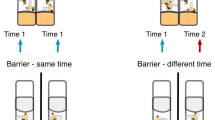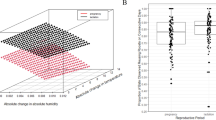Abstract
The effects on mating success of four X-linked mutations controlling locomotor activity are examined. The mutation hypoE has no effect on female mating success. The mutations hypoC, iav and iav2 reduce female mating propensity and extend courtship durations. Unlike wild type females these mutant females fail to reach their maximum propensity for mating on the second day after eclosion. The iav females have normal wild type compositions of cuticular hydrocarbons and are highly attractive to courting males. Attenuated perception or aberrant processing of male courtship stimuli, and delayed sexual maturation are likely contributors to the poor mating propensity of inactive females. The iav mutation also causes decreased mating success and extended courtship duration in male mutants. This is largely a consequence of their inactivity. The duration of courtship latency, which is related to the number of phenotypically inactive flies present in the pairing, is positively correlated with age. Copulation duration, though primarily a male determined trait, is also affected by age. Some inferences regarding possible modes of action of the mutations are discussed.
Similar content being viewed by others
Article PDF
References
Antony, C, Davies, T L, Carlson, D A, Pechine, J H, and Jallon, J-M. 1985. Compared behavioural responses of male Drosophila melanogaster (Canton-S) to natural and synthetic aphrodisiacs. J Chem Ecol, 11, 1617–1629.
Antony, C, and Jallon, J-M. 1981. Evolution des hydro-carbones comportementalement actifs de Drosophila melanogaster au cours de la maturation sexuelle. CK Acad Sci Paris, 252, 239–242.
Antony, C, and Jallon, J-M. 1982. The chemical basis for sex recognition in Drosophila melanogaster. J Insect Physiol, 28, 873–880.
Bastock, M. 1956. A gene mutation which changes a behavior pattern. Evolution, 10, 421–439.
Brown, R G B. 1964. Courtship behaviour in the Drosophila obscura group. Part I: Drosophila pseudoobscura. Behaviour, 23, 61–106.
Burnet, B, and Connolly, K J. 1974. Activity and Sexual Behaviour in Drosophila melanogaster. In van Abeelen, J. H. F. (ed.) The Genetics of Behaviour, North-Holland, Amsterdam, pp. 201–258.
Burnet, B, Burnet, L, Connolly, K J, and Williamson, N J. 1988. A genetic analysis of locomotor activity in Drosophila melanogaster. Heredity, 61, 111–119.
Cobb, M, Burnet, B, and Connolly, K J. 1986. The structure of courtship in the Drosophila melanogaster species subgroup. Behaviour, 97, 182–212.
Cobb, M, Connolly, K J, and Burnet, B. 1985. Courtship behaviour in the melanogaster subgroup of Drosophila. Behaviour, 95, 203–231.
Cobb, M, Connolly, K J, and Burnet, B. 1987. The relationship between locomotor activity and courtship in the melanogaster species subgroup of Drosophila. Anim Behav, 35, 705–713.
Cook, R M. 1973. Physiological factors in the courtship processing of Drosophila melanogaster. J Insect Physiol, 19, 397–406.
Cook, R M. 1979. The courtship tracking of Drosophila melanogaster. Biol Cybernet, 34, 91–106.
Eastwood, W L, and Burnet, B. 1977. Courtship latency in male Drosophila melanogaster. Behav Genet, 7, 359–372.
Evans, P D. 1980. Biogenic amines in the insect nervous system. Adv Insect Physiol, 15, 317–473.
Wing, A W. 1963. Attempts to select for spontaneous activity in Drosophila melanogaster. Anim Behav, 11, 369–378.
Ewing, A W. 1983. Functional aspects of Drosophila courtship. Biol Rev, 58, 275–329.
Gailey, D A, Jackson, F R, and Siegel, R W. 1982. Male courtship in Drosophila: the conditioned response to immature males and its genetic control. Genetics, 102, 771–782.
Gailey, D A, Lacaillade, R C, and Hall, J C. 1986. Chemosensory elements of courtship in normal and mutant, olfaction-déficient Drosophila melanogaster. Behav Genet, 16, 375–405.
Homyk, T. 1977. Behavioral mutants of Drosophila melanogaster. II. Behavioral analysis and focus mapping. Genetics, 87, 105–128.
Jallon, J-M. 1984. A few chemical words exchanged by Drosophila during courtship and mating. Behav Genet, 14, 441–478.
Jallon, J-M, Antony, C, Chan-Yong, T P, and Manier, S. 1986. Genetic factors controlling the production of aphrodisiac substances in Drosophila. In Porchet, M., Andrues, J. C. and Dhainaut, A. (eds.) Advances in Invertebrate Reproduction 4. Elsevier, Amsterdam, pp. 445–452.
Kessler, S. 1968. The genetics of Drosophila mating behaviour. I. Organisation of mating speed in Drosophila pseudoobscura. Anim Behav, 16, 485–491.
Kyriacou, C P. 1981. The relationship between locomotor activity and sexual behaviour in ebony strains of Drosophila melanogaster. Anim Behav, 29, 462–471.
Kyriacou, C P, Burnet, B, and Connolly, K J . (1978). The Behavioural Basis of Overdominance In Competitive Mating Success At The Ebony locus of Drosophila melanogaster. Anim Behav, 26, 1195–1207.
Macbean, I T, and Parsons, P A. 1967. Directional selection for duration of copulation in Drosophila melanogaster. Genetics, 56, 233–239.
Manning, A. 1959. The sexual behaviour of two sibling Drosophila species. Behaviour, 15, 123–145.
Manning, A. 1961. The effects of artificial selection for mating speed in Drosophila melanogaster. Anim Behav, 9, 82–92.
Manning, A. 1963. Selection for mating speed in Drosophila melanogaster based on the behaviour of one sex. Anim Behav, 11, 116–120.
Manning, A. 1967. The control of female receptivity in Drosophila. Anim Behav, 15, 239–250.
Markow, T A, and Hansen, S A. 1981. Multivariate analysis of Drosophila courtship. Proc Natl Acad Sci, 78, 430–434.
Merrell, D J. 1949. Selective mating in Drosophila melanogaster. Genetics, 34, 370–389.
O'Dell, K M C, and Burnet, B. 1988. Effects of the hypoactive and inactive mutants on locomotor activity in Drosophila melanogaster. Heredity 61, 199–207.
O'Dell, K M C, Coulon, J-F, Daivid, J C, Papin, C, Fuzeau-Braesch, S, and Jallon, J-M. 1987. La mutation inactive produit une diminution marquee d'octopamine dans le cerveau des Drosophiles. CK Seances Soc Biol Ser Ill, 305, 199–202.
Pechine, J M, Antony, C, and Jallon, J-M. 1988. Precise characterisation of cuticular compounds in young Drosophila by mass spectrometry. J Chem Ecol, 14, 1071–1085.
Robertson, H M. 1982. Female courtship summation in Drosophila melanogaster. Anim Behav 30, 1105–1117.
Siegel, R W, Hall, J C, Gailey, D A, and Kyriacou, C P. 1984. Genetic elements of courtship in Drosophila melanogaster: mosaics and learning mutants. Behav Genet, 14, 383–410.
Spiess, E B. 1970. Mating propensity and its genetic basis in Drosophila melanogaster. In Heckt, M. K. and Steere, W. C. (ed.) Essays in Honor of Theodosius Dobzhansky, Appleton Century Crofts, New York, pp. 315–379.
Spieth, H T. 1966. Drosophilid mating behaviour: the behaviour of decapitated females. Anim Behav, 14, 226–235.
Streisinger, G. 1948. Experiments on sexual isolation in Drosophila. IX. Behaviour of males with etherized females. Evolution, 2, 187–188.
Sturtevant, A H. 1915. Experiments on sex recognition and the patterns of sexual selection in Drosophila. J Anim Behav, 5, 351–366.
Tan, C C. 1946. Genetics of sexual isolation between Drosophila pseudoobscura and Drosophila persimilis. Genetics, 31, 558–573.
Tompkins, L, Gross, A C, Hall, J C, Gailey, D A, and Siegal, R W. 1982. The role of female movement in the sexual behaviour of Drosophila melanogaster. Behav Genet, 12, 295–307.
Wood, D, Ringo, J M, and Johnson, L L. 1980. Analysis of courtship sequence of the hybrids between Drosophila melanogaster and Drosophila simulans. Behav Genet, 10, 459–466.
Author information
Authors and Affiliations
Rights and permissions
About this article
Cite this article
O'Dell, K., Burnet, B. & Jallon, JM. Effects of the hypoactive and inactive mutations on mating success in Drosophila melanogaster. Heredity 62, 373–381 (1989). https://doi.org/10.1038/hdy.1989.52
Received:
Issue date:
DOI: https://doi.org/10.1038/hdy.1989.52
This article is cited by
-
High fat diet alters Drosophila melanogaster sexual behavior and traits: decreased attractiveness and changes in pheromone profiles
Scientific Reports (2018)
-
Theinactive mutation leads to abnormal experience-dependent courtship modification in maleDrosophila melanogaster
Behavior Genetics (1994)
-
The effect of the inactive mutation on longevity, sex, rhythm and resistance to p-Cresol in Drosophila melanogaster
Heredity (1993)
-
Mating speed and the interplay between female and male courtship responses inDrosophila melanogaster (Diptera: Drosophilidae)
Journal of Insect Behavior (1992)
-
Male sexual signaling is defective in mutants of theapterous gene ofDrosophila melanogaster
Behavior Genetics (1992)



